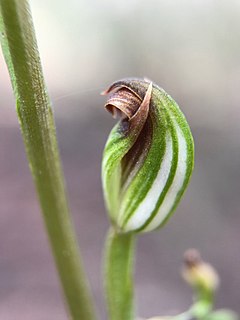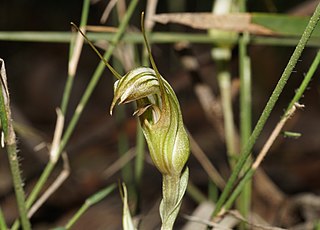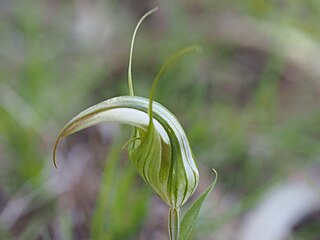
Pterostylis coccina, commonly known as the scarlet greenhood, is a species of orchid endemic to eastern Australia. As with similar greenhoods, the flowering plants differ from those which are not flowering. The non-flowering plants have a rosette of leaves flat on the ground but the flowering plants have a single flower with leaves on the flowering spike. In this species, the rosette leaves are relatively large and dark green, and the flowers are white, and bluish-green or red. It grows in New South Wales and north-eastern Victoria.

Pterostylis curta, commonly known as the blunt greenhood, is a species of orchid found in south-eastern Australia, Lord Howe Island and New Caledonia. It has a rosette of leaves at its base and a single white and green, forward leaning flower with a brown tip and a twisted labellum.

Pterostylis grandiflora, commonly known as the cobra greenhood or superb greenhood, is a species of orchid endemic to south-eastern Australia. As with similar orchids, the flowering plants differ from those which are not flowering. The non-flowering plants have a rosette of leaves but the flowering plants lack a rosette and have a single flower with leaves on the flowering spike. This greenhood has a green and white, striped flower with deep red-brown markings especially on its "galea", and a sharply pointed dorsal sepal.

Pterostylis trullifolia, commonly known as the trowel-leaved greenhood, is an orchid species endemic to New Zealand. As with similar orchids, the flowering plants differ from those which are not flowering. The non-flowering plants have a rosette of wrinkled, trowel-shaped leaves but the flowering plants have a single flower with a bulging, platform-like sinus between the lateral sepals and leaves on the flowering spike.

Pterostylis atrans, commonly known as the dark-tip greenhood or blunt-tongue greenhood, is a species of orchid endemic to south-eastern Australia. As with similar greenhoods, plants in flower differ from those that are not flowering. The non-flowering plants have a rosette of leaves flat on the ground, but the plants in flower have a single flower with leaves on the flowering spike. In this species, the flower is green and reddish brown with a protruding sinus and small club-like tips on the ends of the lateral sepals.

Pterostylis revoluta, commonly known as the autumn greenhood, is a species of orchid endemic to south-eastern Australia. As with similar greenhoods, the flowering plants differ from those which are not flowering. The non-flowering plants have a rosette of leaves flat on the ground but the flowering plants have a single flower with leaves on the flowering spike. This greenhood has white and green flowers which have a long, curved, pointed labellum which extends beyond the sinus between the lateral sepals.

Pterostylis longipetala, commonly known as the curved greenhood, is a species of orchid endemic to eastern Australia. As with similar greenhoods, the flowering plants differ from those which are not flowering. The non-flowering plants have a rosette of leaves flat on the ground but the flowering plants have a single flower with leaves on the flowering spike. This greenhood has dark green, brown and white flowers which lean slightly forwards and have sharply-pointed petals and a long, curved labellum.

Pterostylis rubescens, commonly known as the blushing tiny greenhood, is a species of orchid endemic to south-eastern Australia. As with similar orchids, the flowering plants differ from those which are not flowering. The non-flowering plants have a rosette of leaves but the flowering plants lack a rosette at the base and have up to eighteen tiny green, white and brownish flowers.

Pterostylis amabilis is a species of orchid endemic to eastern Australia. As with similar orchids, the flowering plants differ from those which are not flowering. The non-flowering plants have a rosette of leaves but the flowering plants lack a rosette at the base but have up to ten tiny white and red to reddish-brown flowers. It is similar to P. parviflora but has larger rosette leaves and larger, more brightly coloured flowers.
Pterostylis aquilonia, commonly known as the northern cobra greenhood, is a species of orchid endemic to Queensland. As with similar orchids, the flowering plants differ from those which are not flowering. The non-flowering plants have a rosette of leaves but the flowering plants lack a rosette and have a single flower with leaves on the flowering spike. This greenhood has a relatively large green, white and reddish-brown self-pollinating flower.

Pterostylis sp. aff. alata is a species of orchid endemic to New South Wales but which has not yet been formally described. Non-flowering plants have a rosette of leaves but the flowering plants have a single flower with leaves on the flowering spike. This greenhood has a white flower with green markings and a brown-tipped dorsal sepal. It is only known from areas near Armidale where it grows near south-facing escarpments.
Pterostylis crassichila, commonly known as the plump northern greenhood, is a species of orchid endemic to Queensland. It has a rosette of leaves at the base of the plant and a single white flower with green lines, reddish towards its tip. It grows in higher areas of north Queensland.
Pterostylis erythroconcha, commonly known as the red shell orchid, is a species of orchid endemic to South Australia. As with similar orchids, the flowering plants differ from those which are not flowering. The non-flowering plants have a rosette of leaves but the flowering plants have a single flower with leaves on the flowering spike. This greenhood has a white and green flower with reddish brown markings and a long, fleshy, curved labellum.

Pterostylis hildae, commonly known as the rainforest greenhood, is a species of orchid found in eastern Australia. It has a rosette of leaves and when flowering a rosette at the base of a flowering stem with a single green, white and brown flower. It is found in wet forests, including rainforest in New South Wales and Queensland.

Pterostylis ophioglossa, commonly known as the snake-tongue greenhood, is a species of orchid endemic to eastern Australia. It has a rosette of leaves at the base and a single dull green, white and brown flower with a deeply notched labellum.
Pterostylis procera, commonly known as the short-lipped greenhood, is a species of orchid endemic to Queensland. It has a rosette of leaves and when flowering a single translucent white flower with green and reddish markings and a labellum which does not protrude through the lateral sepals.

Pterostylis reflexa, commonly known as the dainty greenhood, is a species of orchid endemic to New South Wales. As with similar greenhoods, the flowering plants differ from those which are not flowering. The non-flowering plants have a rosette of leaves flat on the ground but the flowering plants have a single flower with leaves on the flowering stem. This greenhood has a relatively large white, green and light brown flower with a long, curved dorsal sepal and a protruding labellum.
Pterostylis riparia, commonly known as the streamside greenhood, is a plant in the orchid family Orchidaceae and is endemic to New South Wales. Both flowering and non-flowering plants have a rosette of dark green, fleshy leaves. Flowering plants have a single relatively large green, white and reddish-brown flower with a deeply notched sinus between hairy lateral sepals.
Pterostylis stricta, commonly known as the northern greenhood, is a species of orchid endemic to Queensland. It has a rosette of leaves and when flowering a single translucent white flower with green lines, a reddish-brown tip and a curved, protruding labellum.

Pterostylis torquata, commonly known as the collared greenhood, is a species of orchid endemic to New South Wales. As with similar greenhoods, the flowering plants differ from those which are not flowering. The non-flowering plants have a rosette of leaves flat on the ground but the flowering plants have a single flower with leaves on the flowering stem. This greenhood has a white flower with dark green and dark brown markings, although in some areas, the flowers lack the brown markings. The sinus between the lateral sepals is platform-like.




















